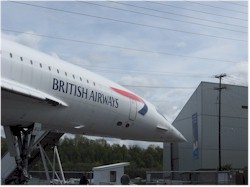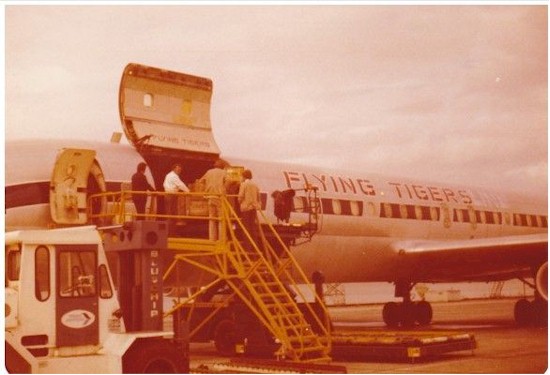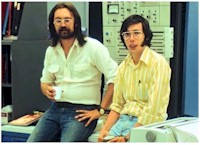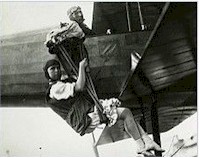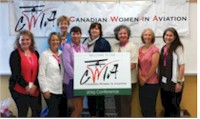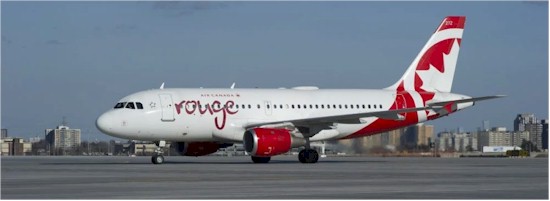|
June 21, 1913: |
 |
|
Issue dated September 2015 (with permission). Attending a Women in Aviation International (WAI) conference during 2015 allows you to hear fascinating stories from special guest speakers – such as a 90-year-old grandmother who got her pilot’s licence at age 60; the woman survivor of a military aircraft crash in the Arctic; a female astronaut who served on the International Space Station; the first female CF-18 pilot; the first female Snowbird pilot and many others.
First Officer Kim Winsor, Captain Suzanne Pettigrew, Captain Rosella Bjornson, Captain Judy Cameron, Flight Dispatcher Denise Egglestone, Manager Process Improvement, Donna Volpini, First Officer Lisa Graham and First Officer Heather Jennings. |
Maureen Ryan Swiednicki sends this comment -
Thank you for the NetLetter! I worked for TCA in Dorval.
I enjoy reading of past exploits of the company, which had a family atmosphere in those days.
I remember when we were attempting to fly to Disney World with our five children; we made it. All TCA employees helped as we were all in the same boat (old expression).
My son Lance followed in his father’s footsteps and today he works out of Calgary.
Applause to all of you,
Maureen Ryan Swiednicki
After reading the article in NetLetter #1436 with regard to the "WACA News", Aron Charad sends this amusing narrative regarding the issuance of the WACA newsletter.
Back in 1978 the "WACA News" was produced every 3 months.
The print run was thousands of copies, and were sent to a British Airways contact in London who, in turn, would put them in the airline's company mail to Gerry Philbrook.
All the VP's around the world, pictured in the article, received copies and then sent them to member clubs for distribution.
Now it’s done with a touch of a button to each member. Gotta love technology!!
|
Ralph Quick shares this memory - TCA Vickers Viscount Winnipeg 1955. In the past year there have been stories regarding the venerable Viscount that started service with TCA in April of 1955. It occurs to me at age 86, I might be one of the only living pilots that knows of this training accident, re: the first aircraft. In the spring of 1955 I had been laid off by TCA as a junior mechanic after 2 ½ years service. I then, as a commercial pilot with an instructor's rating, was employed by the Winnipeg Flying Club. Taxiing out with a student one day I was given a front row seat to the following drama. As we started our taxi for runway 07, I observed the brand new Viscount taking off on runway 18. It was obviously a training flight as number 1 engine feathered on takeoff and the aircraft continued with the nose wheel pressed firmly on the ground. When we arrived at the button of Runway 07 (on the grass) we were right beside Runway 18. The Viscount had completed its circuit and was landing with the prop feathered. I admired a smooth landing and as the nose wheel touched the pavement the landing gear retracted. As he passed us the number 2 prop departed the aircraft and cartwheeled down the runway ahead of the aircraft as it slid down the runway with the rear door opening before the aircraft came to a stop. The pilots had run the whole length of the aircraft while it was still sliding and promptly jumped to the pavement and departed rapidly. Seeing everyone was safe I couldn’t restrain a laugh as the scene had a certain comical air to it. I found out later what had happened. When the number 1 engine was feathered the pilot kept the a/c straight using the nose wheel. After takeoff the gear was selected up with no retraction occurring. The gear lever was activated both ways several times with no joy. The aircraft landed with three green lights indicating gear down and locked. The nose wheel that had helped the aircraft keep straight on takeoff and was cocked to the side, centered and, because the gear lever had been left in the up position after all the selections, the gear did what it was told and promptly retracted. The aircraft had been designed that if the nose wheel was not straight the gear would not retract and damage the wheel well. I cannot recall any mention of this in the newspapers and I do not believe I ever saw or heard any mention of it, but it did happen. So this can be added to the folklore of this fine pioneer aircraft. Ralph Quick |
|
The NetLetter found this information regarding the incident - May 16, 1955 CF-TGJ fin 602 c/n 41. After a three engine training flight the undercarriage collapsed on landing at Winnipeg Airport, Manitoba, Canada. The aircraft had taken off with three pilots on board, and once airborne the undercarriage was retracted but it stayed in the down position. The undercarriage was cycled down and up but nothing changed. The visual indicators and the three green lights showed that the undercarriage was safely locked down. On landing the undercarriage slowly retracted resulting in lower fuselage and propeller damage and shock load damage to the Rolls-Royce Dart engines. The cause of the initial failure to retract the undercarriage was not determined, but the collapse on landing was due to the undercarriage select lever being left in the 'up' position. Repaired and returned to service. (Source: www.vickersviscount.net) |
|
Larry Harris sends us this memory - In 1967-68 the pulp mill at Powell River conducted a major construction program. A lot of the workers came from out of town and during the week they stayed in camp, but liked to get home for the weekends. PWA scheduled an extra section on Friday afternoons between Powell River (YPW) and Vancouver (YVR) with a return flight on Sundays to accommodate those that wanted to get home. On one occasion the aircraft they were using that day was a DC-3. The plane arrived and shut down the engines and shortly after that the 32 passengers were loaded and the pilot was given the go-ahead to start the engines. Sadly the batteries had died during the shut-down and we were stuck as Powell River did not have a ground power unit and a car certainly would not work. Agent Tom Bond remembered seeing something done with a length of rope to help get the engine going. We rounded up about 100 feet of rope and Tom climbed a ladder up towards the front of the engine. The DC-3 propeller has a cone at the center of it covering the bolts that hold the propeller in place. Tom proceeded to wrap the rope around the spinner tightly and told the pilot to hit the starter switch when the rope comes off and the prop is spinning. As all the passengers were now outside watching, we got about 20 of them to pull on the rope. It didn’t take long for the rope to come off and the prop was spinning at a great speed. The pilot hit the starter switch and the result was one, well running, engine. The second engine powered off the first so it did not need the rope. Shortly after that the 32 passengers boarded the plane and were whisked off to Vancouver (YVR). |

